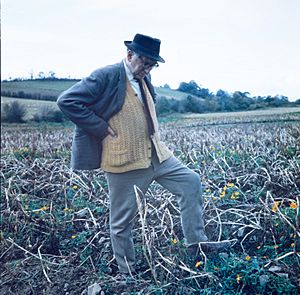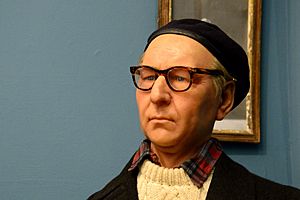Patrick Kavanagh facts for kids
Quick facts for kids
Patrick Kavanagh
|
|
|---|---|
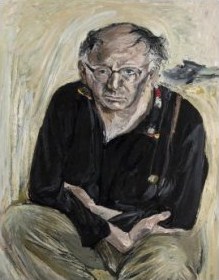
Patrick Kavanagh, by Patrick Swift, 1960
|
|
| Born | 21 October 1904 Inniskeen, County Monaghan, Ireland |
| Died | 30 November 1967 (aged 63) Dublin, Ireland |
| Occupation | Poet |
| Nationality | Irish |
| Period | 1928–1967 |
| Genre | Irish poet, novelist |
| Subject | Irish life, nature |
Patrick Kavanagh (born 21 October 1904 – died 30 November 1967) was a famous Irish poet and writer. He wrote about everyday Irish life and nature. Some of his most well-known works include the book Tarry Flynn and the poems "On Raglan Road" and "The Great Hunger".
Life and Writing Journey
Early Life and Childhood
Patrick Kavanagh was born in a small country area called Inniskeen, in County Monaghan, Ireland, in 1904. He was the fourth of ten children in his family. His father, James, worked as a shoemaker and also farmed the land. Patrick's brother, Peter, later became a university professor and writer. Several of his sisters became teachers or nurses.
Patrick went to Kednaminsha National School from 1909 to 1916. He left school at age 13 after finishing sixth class. After school, he learned shoemaking from his father and helped out on the family farm. He also played as a goalkeeper for the local Gaelic football team, the Inniskeen Grattans. He once said that even though he grew up in a poor area, the real problem was a "lack of enlightenment," meaning a lack of knowledge and understanding.
Starting His Writing Career
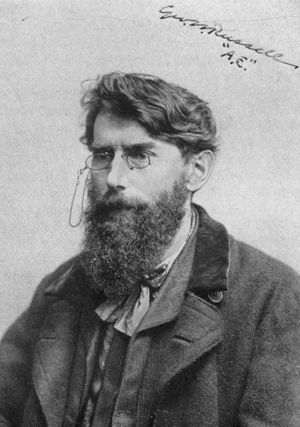
Kavanagh's first writings were published in 1928 in local newspapers. He discovered a magazine called the Irish Statesman, which was edited by George William Russell, also known as AE. Russell was a key figure in the Irish Literary Revival, a time when Irish writers were creating new and important works.
Russell first turned down Kavanagh's poems but told him to keep trying. He then published some of Kavanagh's poems in 1929 and 1930. This encouraged Patrick, who was still a farmer, to leave home and try to become a full-time writer. In 1931, he walked about 129 kilometers (80 miles) to meet Russell in Dublin. Russell gave Kavanagh many books by famous writers like Fyodor Dostoyevsky and Walt Whitman. Russell became an important guide for Kavanagh's writing. Kavanagh also joined Dundalk Library, and one of the first books he borrowed was The Waste Land by T. S. Eliot.
Kavanagh's first collection of poems, Ploughman and Other Poems, came out in 1936. This book was special because it showed Irish country life in a very real way. It didn't make rural life seem overly romantic, which was common in poems at that time. The book used everyday language and focused on the true lives of ordinary people. This style was not always popular with the traditional literary groups.
In 1938, Kavanagh visited London for about five months. His book The Green Fool, which was partly about his own life, was published that year. In the book, Kavanagh wrote about visiting a writer named Oliver St. John Gogarty. Gogarty sued Kavanagh for something he wrote, and Kavanagh had to pay money. Despite this, the book was recognized internationally and received good reviews. It told the story of Kavanagh's childhood in the countryside and his efforts to become a writer.
Life During The Emergency
When World War II started, it was known as The Emergency in Ireland because the country remained neutral. This period made it hard for some Irish writers, including Kavanagh, to publish their books because they lost contact with their publishers in London.
In 1939, Kavanagh moved to Dublin. He soon realized that the city's literary scene was not as exciting as he had hoped. He felt that many Dublin writers were just pretending to be artistic. He believed they treated him like a simple farmer instead of the talented poet he was becoming.
In 1942, Kavanagh published a long poem called The Great Hunger. This poem described the difficulties and struggles of rural life that he knew so well. Many critics consider this to be Kavanagh's best work. It aimed to show the harsh reality of peasant life, going against the overly sweet and romantic ideas often presented by other Irish writers. Richard Murphy called it "a great work," and Robin Skelton praised it as "a vision of mythic intensity."
After the War
Kavanagh worked as a part-time journalist, writing a gossip column for the Irish Press newspaper from 1942 to 1944. He also reviewed films for the same newspaper from 1945 to 1949. In 1946, the Archbishop of Dublin, John Charles McQuaid, helped Kavanagh get a job at a Catholic magazine called The Standard. The Archbishop continued to support him throughout his life.
Kavanagh's book Tarry Flynn, which was partly based on his own life, was published in 1948. It was banned for a short time. The book tells a fictional story about life in the countryside. It was later turned into a play and performed at the Abbey Theatre in 1966.
In late 1946, Kavanagh moved to Belfast for a while. He worked as a journalist and also as a barman in pubs in the Falls Road area. He later returned to Dublin in November 1949.
Later Years and Recognition
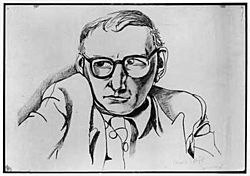
In 1949, Kavanagh started writing a monthly "Diary" for Envoy, a literary magazine started by John Ryan. Ryan became a lifelong friend and supporter of Kavanagh. Through Envoy, Kavanagh met many young artists and thinkers. He often called this time his "poetic rebirth."
In 1952, Kavanagh and his brother Peter started their own magazine called Kavanagh’s Weekly: A Journal of Literature and Politics. It was published for about three months.
Lawsuit and Health Challenges
In 1954, two important things happened in Kavanagh's life. He was involved in a lawsuit with a magazine called The Leader. He had written critical pieces about various groups, and someone wrote an article about him in The Leader that he felt was unfair. He believed he would settle the case out of court. However, the magazine hired a very skilled lawyer, John A. Costello, who won the case against Kavanagh.
Soon after losing the lawsuit, Kavanagh was diagnosed with lung cancer. He had surgery to remove a lung. While recovering from this operation, he spent time relaxing by the Grand Canal in Dublin. It was during this time that he found new inspiration for his poetry. He began to truly appreciate nature and his surroundings, and these became the focus of many of his later poems. Interestingly, Kavanagh and Costello later became good friends.
Gaining Acclaim
In 1955, a publisher turned down a collection of Kavanagh's poems, which made him very sad. However, his friend Patrick Swift helped him. Swift arranged for the poems to be published in an English literary magazine called Nimbus in 1956. This was a turning point for Kavanagh. He finally started to receive the praise and recognition he felt he deserved. His next collection, Come Dance with Kitty Stobling, was a direct result of these poems.
Between 1959 and 1962, Kavanagh spent more time in London. He also gave lectures at University College Dublin and in the United States. He represented Ireland at literary events and became a judge for poetry awards. In 1964, his Collected Poems was published. In the introduction, Kavanagh wrote: "A man innocently dabbles in words and rhymes, and finds that it is his life."
Marriage and Passing
Kavanagh married his long-time partner, Katherine Barry Moloney, in April 1967. They made their home together in Dublin. Kavanagh became ill during the first performance of his play Tarry Flynn in Dundalk. He passed away a few days later, on 30 November 1967, in Dublin. He is buried in Inniskeen, next to the Patrick Kavanagh Centre. His wife Katherine, who died in 1989, is also buried there.
Legacy and Influence
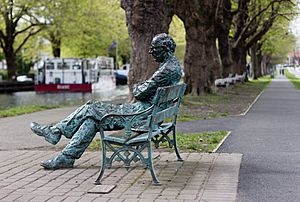
The famous poet and Nobel Prize winner Séamus Heaney was greatly influenced by Patrick Kavanagh. Heaney believed that Kavanagh's poetry changed Irish culture and helped inspire the poets who came after him. Heaney said that Kavanagh taught poets to see the difference between being "parochial" (focused on a small, local area) and "provincial" (having a narrow, old-fashioned mindset). Kavanagh himself believed that "All great civilizations are based on the parish," meaning that important ideas can come from focusing on local life.
The actor Russell Crowe has said he is a fan of Kavanagh's work. He likes how Kavanagh's poems are clear and emotional. In 2002, after winning an award for his acting, Crowe quoted Kavanagh in his acceptance speech.
When the Irish Times newspaper asked people for their favorite Irish poems in 2000, ten of Kavanagh's poems were in the top 50. He was ranked the second favorite poet, after W. B. Yeats. Kavanagh's poem "On Raglan Road" is very popular. It has been turned into a song and performed by many different artists.
There is a statue of Kavanagh next to Dublin's Grand Canal. It was inspired by his poem "Lines written on a Seat on the Grand Canal, Dublin," where he wrote:
O commemorate me where there is water
canal water preferably, so stilly
greeny at the heart of summer. Brother
commemorate me thus beautifully.
Every year on 17 March, after the St. Patrick's Day parade, a group of Kavanagh's friends gather at this statue to honor him. There are also other statues of Patrick Kavanagh in Dublin and even at Walt Disney World in Florida.
The Patrick Kavanagh Poetry Award is given out each year for a collection of poems that has not yet been published. The annual Patrick Kavanagh Weekend is held in Inniskeen, where he was born. The Patrick Kavanagh Centre, a museum dedicated to the poet, is also located in Inniskeen.
Kavanagh's Writings Archive
In 1986, Patrick Kavanagh's brother, Peter, arranged for Patrick's writings and papers to be sold to University College Dublin. This collection is kept in a special room at the university's library. It includes:
- Early writings like poems, novels, and other published works.
- Letters between family members and letters Patrick received from others.
- Later writings, including more poems, articles, and lectures.
- Documents about the lawsuit he had with The Leader magazine.
- Personal letters, including those with his sisters and his wife, Katherine.
- Printed materials, newspaper clippings, and tape recordings.
Peter Kavanagh's own papers are also part of this collection.
Copyright Information
The legal rights to Patrick Kavanagh's works belong to the Trustees of The Patrick and Katherine Kavanagh Trust. This trust was set up by his wife, Kathleen Kavanagh, after his death. The money earned from his works is used to support other deserving writers.
Works by Patrick Kavanagh
Poetry
- 1936 – Ploughman and Other Poems
- 1942 – The Great Hunger
- 1947 – A Soul For Sale
- 1958 – Recent Poems
- 1960 – Come Dance with Kitty Stobling and Other Poems
- 1964 – Collected Poems (ISBN: 0 85616 100 4)
- 1972 – The Complete Poems of Patrick Kavanagh, edited by Peter Kavanagh
- 1978 – Lough Derg
- 1996 – Selected Poems, edited by Antoinette Quinn (ISBN: 0140184856)
- 2004 – Collected Poems, edited by Antoinette Quinn (ISBN: 0-713-99599-8)
Prose (Written Works)
- 1938 – The Green Fool
- 1948 – Tarry Flynn (ISBN: 0141183616)
- 1964 – Self Portrait – recording
- 1967 – Collected Pruse
- 1971 – November Haggard – a collection of prose and poetry edited by Peter Kavanagh
- 1978 – By Night Unstarred – a novel completed by Peter Kavanagh
- 2002 – A Poet's Country: Selected Prose, edited by Antoinette Quinn (ISBN: 1843510103)
Plays and Adaptations
- 1966 – Tarry Flynn, adapted by P. J. O'Connor
- 1986 – The Great Hunger, adapted by Tom Mac Intyre
- 1992 – Out of That Childhood Country – a play about Kavanagh’s youth by John McArdle, co-written with Tommy McArdle and Eugene MacCabe
- 1997 – Tarry Flynn, adapted by Conall Morrison (modern dance and play)
- 2004 – The Green Fool, adapted by Upstate Theatre Project
Images for kids


